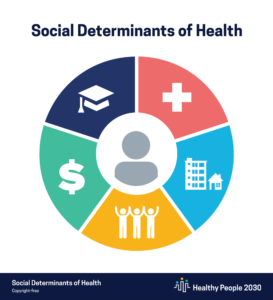Don’t Despair: National Minority Health Month

By: Sharazazi Dyson, MEd
April is National Minority Health Month (NMHM), which is a time to raise awareness about health disparities that continue to affect people from racial and ethnic minority groups and encourage action through health education, early detection, and control of disease complications. This blog post will give a brief historical background on access and fear related to the medical field, examples of disparities/inequities, and reflective questions we can all use. In this blog post “minorities” will be replaced with “people of color”, meaning those who are marginalized by their race. You might also be wondering what is meant by “disparities”, they are differences in the presence of disease, health outcomes, or access to health care. As you read and consider the impact of race, also consider them being differences that are unnecessary and avoidable.
Historical Background
People of color in the United States navigate social, political, and cultural systems that can create barriers to access counseling and medical support. There are histories of scientific racism from the 19th and 20th centuries including eugenics sterilization programs and craniometry of Black and Indigenous women (Renuncio-Martinez, 2007). Even the Johns Hopkins’ Kennedy Krieger Institute study in which they studied potential lead reduction methods in homes lived in by African American families and their children to find an inexpensive means to treat lead poisoning (Rosner & Markowitz, 2012). Some families sued stating they were not fully informed of the study, test results, or risks to themselves and their children (Buchanan & Miller, 2006).
Those horrifying experiences happened in the larger medical realm, but the counseling profession has also directly intersected with disparities. In a study seeking to describe reasons for the unmet need for mental health care among Black people, one focus group participant recalled how “Black people have gone into the mental health system to get help but have lost things that are important to them such as their children, jobs, and their sense of control” (Alang, 2019, p. 351). As a clinician, I fight to undo that stigma and untangle that fear, but the first step is to recognize it exists.
Disparities in-Depth
Disparities in health and healthcare not only affect the groups facing disparities but also limit overall gains in quality of care and health for the broader population and result in unnecessary costs, costs to our world and our communities. Health inequities can be disproportionately experienced and/or the consequences of a disease can be disproportionate. Health and health care disparities are commonly viewed through the lens of race and ethnicity which we focus on here, but they occur across a broad range of dimensions. For example, disparities occur across socioeconomic status, age, geography, language, gender, disability status, citizenship status, and sexual identity and orientation. As such, addressing health disparities is increasingly important as the population becomes more diverse.
To give an example of a health disparity, Black women are 40% more likely to die of breast cancer than white women even though Black women get mammograms as often as white women (Richardson, et al., 2016). This disparity appears in part because;
- Black women get follow-up care later than white women.
- Black women have different treatment experiences than white women.
- Fewer black women receive the surgery, radiation, and hormone treatments they need compared to white women.
Social Determinants of Health

Social determinants of health (SDOH) are the conditions in the environments where people are born, live, learn, work, play, worship, and age that affect a wide range of health, functioning, and quality-of-life outcomes and risks. This means that health and health outcomes are not just within individual control that can be overcome with individual change.
Examples of SDOH include:
- Safe housing, transportation, and neighborhoods
- Racism, discrimination, and violence
- Education, job opportunities, and income
- Access to nutritious foods and physical activity opportunities
- Polluted air and water
- Language and literacy skills
You may read the above examples of SDOHs and feel despair about what can actually be done because it takes more than one person, one donation or one event. You can start with the following questions, chat with your friends, family and loved ones and see where the responses take you and what resources you uncover. If you find, as you reflect that you are finding ways you are experiencing or have experienced these disparities and it’s causing you distress, I also urge you to speak with a counseling professional.
- What is the nature and scope of the inequity or problem?
- What impact does it have on marginalized communities?
- What historic and present-day factors help create the problem?
- What can I do to help address the problem?
- Who is already doing the work to address this problem?
- What changes need to be made to help relieve the inequity?
(Questions adapted from the Learning for Justice, Racial Disparities Jigsaw Mini-Unit)
Request an Appointment with Sharazazi Today
References
- Alang, S. M. (2019). Mental health care among blacks in America: Confronting racism and constructing solutions. Health Services Research, 54(2), 346–355. https://doi.org/10.1111/1475-6773.13115
- Buchanan, D. R., & Miller, F. G. (2006). Justice and Fairness in the Kennedy Krieger Institute Lead Paint Study: the Ethics of Public Health Research on Less Expensive, Less Effective Interventions. American Journal of Public Health, 96(5), 781–787. https://doi.org/10.2105/AJPH.2005.063719
- Healthy People 2030, U.S. Department of Health and Human Services, Office of Disease Prevention and Health Promotion. Retrieved [date graphic was accessed], from https://health.gov/healthypeople/objectives-and-data/social-determinants-health
- Renuncio-Martinez, Vanessa. (2007) Our inalienable right to [health] care: Blacks, ideological whiteness, and the United States health care system. Association for the Study of African American Life and History
- Richardson LC, Henley J, Miller J, Massetti G, Thomas CC. Patterns and trends in black-white differences in breast cancer incidence and mortality—United States, 1999–2013. MMWR 2016;65(40):1093–1098.
- Rosner, D., & Markowitz, G. (2012). With the best intentions: Lead research and the challenge to public health. American Journal of Public Health, 102(11), 19–34. https://doi.org/10.2105/AJPH.2012.301004
- Trivedi, S. (2019). The Harm of Child Removal. SSRN Electronic Journal. https://doi.org/10.2139/ssrn.3341033

